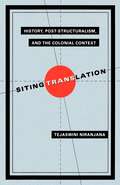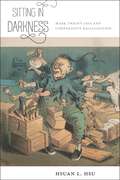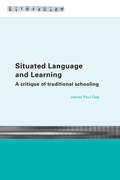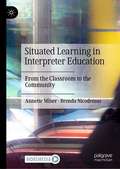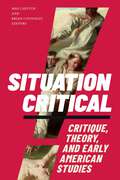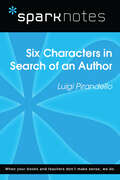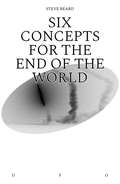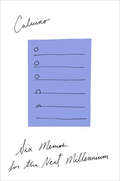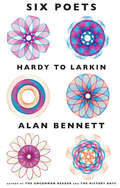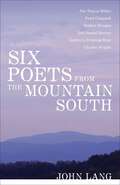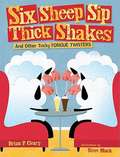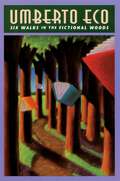- Table View
- List View
Siting Translation: History, Post-Structuralism, and the Colonial Context
by Tejaswini NiranjanaThe act of translation, Tejaswini Niranjana maintains, is a political action. Niranjana draws on Benjamin, Derrida, and de Man to show that translation has long been a site for perpetuating the unequal power relations among peoples, races, and languages. The traditional view of translation underwritten by Western philosophy helped colonialism to construct the exotic "other" as unchanging and outside history, and thus easier both to appropriate and control.Scholars, administrators, and missionaries in colonial India translated the colonized people's literature in order to extend the bounds of empire. Examining translations of Indian texts from the eighteenth century to the present, Niranjana urges post-colonial peoples to reconceive translation as a site for resistance and transformation.
Sitting in Darkness: Mark Twain's Asia and Comparative Racialization (America and the Long 19th Century #7)
by Hsuan L. HsuPerhaps the most popular of all canonicalAmerican authors, Mark Twain is famous for creating works that satirizeAmerican formations of race and empire. While many scholars have exploredTwain’s work in African Americanist contexts, his writing on Asia and AsianAmericans remains largely in the shadows. In Sitting in Darkness, Hsuan Hsuexamines Twain’s career-long archive of writings about United States relationswith China and the Philippines. Comparing Twain’s early writings about Chineseimmigrants in California and Nevada with his later fictions of slavery andanti-imperialist essays, he demonstrates that Twain’s ideas about race were notlimited to white and black, but profoundly comparative as he carefully craftedassessments of racialization that drew connections between groups, includingAfrican Americans, Chinese immigrants, and a range of colonial populations.Drawing on recent legal scholarship,comparative ethnic studies, and transnational and American studies, Sitting inDarkness engages Twain’s best-known novels such as Tom Sawyer, HuckleberryFinn, and A Connecticut Yankee in King Arthur’s Court, as well as hislesser-known Chinese and trans-Pacific inflected writings, such as theallegorical tale “A Fable of the Yellow Terror” and the yellow face play AhSin. Sitting in Darkness reveals how within intersectional contexts of ChineseExclusion and Jim Crow, these writings registered fluctuating connectionsbetween immigration policy, imperialist ventures, and racism.
Sitton Spelling And Word Skills Practice Book 3: Level 3 The Zoo
by Rebecca SittonSpelling Practice Book For Grade 3
Sitton Spelling and Word Skills Practice Book 4
by Rebecca Sitton Donna BernardNIMAC-sourced textbook
Situated Language and Learning: A Critique of Traditional Schooling (Literacies)
by James Paul GeeWhy do poor and minority students under-perform in school? Do computer games help or hinder learning? What can new research in psychology teach our educational policy-makers?In this major new book, Gee tackles the 'big ideas' about language, literacy and learning, putting forward an integrated theory that crosses disciplinary boundaries, and applying it to some of the very real problems that face educationalists today.Situated Language and Learning looks at the specialist academic varieties of language that are used in disciplines such as mathematics and the sciences. It argues that the language acquisition process needed to learn these forms of language is not given enough attention by schools, and that this places unfair demands on poor and minority students.The book compares this with learning as a process outside the classroom, applying this idea to computer and video games, and exploring the particular processes of learning which take place as a child interacts with others and technology to learn and play. In doing so, Gee examines what video games can teach us about how to improve learning in schools and engages with current debates on subjects such as 'communities of practice' and 'digital literacies'.Bringing together the latest research from a number of disciplines, Situated Language and Learning is a bold and controversial book by a leading figure in the field, and is essential reading for anyone interested in education and language.
Situated Learning in Interpreter Education: From the Classroom to the Community
by Brenda Nicodemus Annette MinerThis book provides a theoretical and pragmatic guide to the use of situated learning within structured interpreting programs. Proponents of situated learning theory believe that meaningful learning occurs when students interact with others in the social contexts in which they will be working. With such interactions, students have the opportunity to apply their theoretical knowledge to authentic contexts that they will encounter throughout their professional lives. While a limited number of research articles exist about the use of situated learning in interpreter education, this is the first full book to provide the foundations for situated learning theory, show how to implement situated learning in interpreter education, and offer practical applications for maximizing authenticity in interpreting classrooms.
Situated Learning in Translator and Interpreter Training: Bridging research and good practice
by Maria González-Davies and Vanessa Enríquez RaídoSituated Learning is generally understood as a context-dependent approach to translator and interpreter training under which learners are exposed to real-life and/or highly simulated collaborative work environments and tasks, both inside and outside the classroom. Ultimately, Situated Learning seeks to enhance learners’ capacity to think and act like professionals. This book sets out to gauge the extent to which different factors influence the implementation of Situated Learning models in various teaching and learning contexts. It presents an understanding of Situated Learning that goes beyond previous interpretations of this notion, traditionally dominated by the discussion of pedagogical practices in authentic, i.e. real-world, or semi-authentic professional settings. This wider remit of Situated Learning encompasses previously underrepresented contextual factors pertaining to translation traditions, historical trends, community beliefs and customs, socio-economic constraints, market conditions, institutional practices, budgetary issues, or resource availability. The pedagogical considerations of these key aspects make this book particularly useful for both novice and seasoned teachers of translation and interpreting with an interest in informed practical advice on how to implement the principles of Situated Learning in collaborative teaching and learning environments that seek to promote translators’ and/or interpreters’ professional competence. This book was originally published as a special issue of The Interpreter and Translator Trainer.
Situated Learning: Legitimate Peripheral Participation (The Macat Library)
by Charmi PatelSocial anthropologist Jean Lave and computer scientist Etienne Wenger’s seminal Situated Learning helped change the fields of cognitive science and pedagogy by approaching learning from a novel angle. Traditionally, theories of learning and education had focused on processes of cognition – the mental processes of knowledge formation that occur within an individual. Lave and Wenger chose to look at learning not as an individual process, but a social one. As so often with the creative thinking process, a small, simple shift in emphasis was all that was required to show things in an entirely different light. What Situated Learning illustrated – and emphasized – was that learning is dependent on its social situation. Even though the most effective way to learn is through interaction with experts and peers in a community organized around a common interest, the traditional cognitive learning model failed to account for the way in which learners interact with their ‘community of practice.’ The new hypothesis that Lave and Wenger developed was that learning can be seen as a continuously evolving set of relationships situated within a social context. This allowed Lave and Wenger to place discussions of apprenticeship and workplace learning on a new footing – and led in turn to the book’s impressive impact in business and management scholarship.
Situated Literacies: Theorising Reading and Writing in Context (Literacies)
by David Barton Mary Hamilton Roz IvaničSituated Literacies is a rich and varied collection of key writings from leading international scholars in the field of literacy. Each contribution, written in a clear, accessible style, makes the link between literacies in specific contexts and broader social practices.Detailed ethnographic studies of a wide variety of specific situations, all involving real texts and lived practices, are balanced with general claims about the nature of literacy. Contributors address a coherent set of issues:* the visual and material aspects of literacy* concepts of time and space in relation to literacy* the functions of literacies in shaping and sustaining identities in communities of practice* the relationship between texts and the practices associated with their usethe role of discourse analysis on literacy studiesThese studies, along with a foreword by Denny Taylor, make a timely and important contribution to literacy theory and suggest directions for the further development of the field. Situated Literacies is essential reading for anyone involved in literary education.
Situating Poetry: Covenant and Genre in American Modernism
by Joshua Logan WallA retelling of American modernism through the lines of solidarity and division within and among ethnic and religious identities found in poetry.What happens if we approach the reading and writing of poetry not as an individual act, but as a public one? Answering this question challenges common assumptions about modern poetry and requires that we explore the important questions that define genre: Where is this poem situated, and how did it get there?Joshua Logan Wall's Situating Poetry studies five poets of the New York literary scene rarely considered together: James Weldon Johnson, Charles Reznikoff, Lola Ridge, Louis Zukofsky, and Robert Hayden. Charting their works and careers from 1910–1940, Wall illustrates how these politically marginalized writers from drastically different religious backgrounds wrestled with their status as American outsiders. These poets produced a secularized version of America in which poetry, rather than God, governed individual obligations to one another across multiethnic barriers.Adopting a multiethnic and pluralist approach, Wall argues that each of these poets—two Black, two Jewish, and one Irish-American anarchist—shares a desire to create more truly democratic communities through art and through the covenantal publics created by their poems despite otherwise sitting uncomfortably, at best, within a more standard literary history. In this unique account of American modernist poetics, religious pluralism creates a lens through which to consider the bounds of solidarity and division within and among ethnic identities and their corresponding literatures.
Situation Critical: Critique, Theory, and Early American Studies
by Max Cavitch and Brian Connolly, eds.The contributors to Situation Critical argue for the continued importance of critique to early American studies, pushing back against both reductivist neo-empiricism and so-called postcritique. Bringing together essays by a diverse group of historians and literary scholars, editors Max Cavitch and Brian Connolly demonstrate that critique is about acknowledging that we are never simply writing better or worse accounts of the past, but accounts of the present as well. The contributors examine topics ranging from the indeterminacy of knowledge and history to Black speculative writing and nineteenth-century epistemology, the role of the unconscious in settler colonialism, and early American writing about masturbation, repression, religion, and secularism and their respective influence on morality. The contributors also offer vital new interpretations of major lines of thought in the history of critique—especially those relating to Freud and Foucault—that will be valuable both for scholars of early American studies and for scholars of the humanities and interpretive social sciences more broadly.Contributors. Max Cavitch, Brian Connolly, Matthew Crow, John J. Garcia, Christopher Looby, Michael Meranze, Mark J. Miller, Justine S. Murison, Britt Rusert, Ana Schwartz, Joan W. Scott, Jordan Alexander Stein
Situational Context of Education: A Window Into the World of Bilingual Learners
by Mar¡a Estela Brisk Angela Burgos Sara Ruth HamerlaThis book gives educators important answers to the urgent question of how teachers and schools can facilitate language minority and immigrant students' progress in school. It offers an innovative and powerful method teachers and students can use to study the situational context of education, providing both the theoretical background and the practical tools to implement this approach. The situational context of education includes linguistic, economic, social, cultural, and political factors, as well as conditions, such as students' personal characteristics, family support, and quality of instruction. All of these factors influence the lives of students and their academic performance and contribute in many ways, some subtle and indirect, to making the educational experience more or less difficult for different students. The premise of the book is that objective study of the situational context of education by both students and teachers is beneficial because it leads to a more realistic view of how to facilitate students' progress in school. Designed as a text for graduate courses for preservice and in-service teachers working with students in bilingual, ESL, mainstream, and special education classrooms, the goal is to engage readers in learning not only from the literature but also from studying the situational contexts of their own students. The focus here is on the factors that affect language minority and immigrant students in the United States, but the framework is equally powerful for work with student populations in other social contexts. *The Introduction includes an overview of the theory behind the study of the situational context of education and the implementation of this approach; describes the context of the pilot lessons included in the book; and explains how to use the lessons detailed in later chapters. *Chapters 2-6 focus on different factors in the situational context of education: linguistic, economic, social, cultural, and political. A three-part structure is used: "Classroom Implementation" (a rich description of one lesson in a real classroom); "Context Variables" (a theoretical explanation of the specific factor the chapter addresses, providing the research basis for the sample lesson objectives ); "Doing Analysis of the Context" (several sample lessons for implementation). The lessons are addressed to the teacher, with detailed ideas on how to carry out the lesson and evaluate the students' understanding of the situational context. *Five Appendices provide helpful resources for the implementation of the lessons: an Annotated bibliography of relevant K-12 children's literature; Instructional Approaches; Scoring Rubrics for Content Objectives; Guidelines for a Contrastive Study of Situational Context; and Lesson Template. The lessons have been thoroughly field-tested with students and teachers. Because these lessons work on multiple levels, Situational Context of Education: A Window Into the World of Bilingual Learners benefits students from first grade through preservice and in-service teachers in university courses. Teachers get to know their students and their predicaments within the social context of the United States, and at the same time, the lesson activities have a great impact on the students in their classes. All are helped to achieve academically while gaining awareness of situational factors affecting their lives.
Situational Privacy and Self-Disclosure: Communication Processes in Online Environments
by Philipp K. MasurUsing both a theoretical argumentation and an empirical investigation, this book rationalizes the view that in order to understand people’s privacy perceptions and behaviors, a situational perspective needs to be adopted.To this end, the book is divided into three parts. Part I advances the theory of situational privacy and self-disclosure by discussing impacts of new information and communication technologies on traditional theories of privacy and self-disclosure. Based on five basic suppositions, it describes three major processes of the theory: pre-situational privacy regulations processes, situational privacy perception and self-disclosure processes, and post-situational evaluation processes. Next, Part II presents the application of the theory to smartphone-based communication. It first analyses how people choose certain communication environments on their smartphones, how they manipulate them, and how these external factors affect self-disclosure within these environments. It then details a multi-method study conducted to test the derived assumptions and discusses the obtained results. Part III reflects on the overall implications of the theory, summarizes the major findings and lastly considers possible extensions and perspectives on future research.Intended mainly for researchers in privacy and communication studies, the book offers privacy scholars a systematic review of both classic and contemporary theories of privacy and self-disclosure. At the same time, communication scholars benefit from an additional methodological discussion of the mobile experience sampling method, which provides an invaluable approach to measuring situational communication processes.
Situations and Speech Acts: Toward a Formal Semantics of Discourse (RLE: Discourse Analysis)
by David A. EvansFirst published in 1985, this book aims to develop an approach to speech acts that has the virtue of being straight-forward, explicit, formal and flexible enough to accommodate many of the more general problems of interactive verbal communication. The first chapter introduces situation semantics with the second addressing the assumptions implied by the problem of representing speaker intentionality. The third chapter presents a streamlined theory of speech acts and the fourth tests the predictions of the theory in several hypothetical discourse situations. A summary and suggestions for further research is provided in chapter five, and appendices facilitate reference to key concepts.
Six Characters in Search of an Author (SparkNotes Literature Guide Series)
by SparkNotesSix Characters in Search of an Author (SparkNotes Literature Guide) by Luigi Pirandello Making the reading experience fun! Created by Harvard students for students everywhere, SparkNotes is a new breed of study guide: smarter, better, faster. Geared to what today's students need to know, SparkNotes provides: *Chapter-by-chapter analysis *Explanations of key themes, motifs, and symbols *A review quiz and essay topicsLively and accessible, these guides are perfect for late-night studying and writing papers
Six Concepts for the End of the World (Goldsmiths Press / Unidentified Fictional Objects)
by Steve BeardA navigational aid to the apocalypse.Steve Beard's Six Concepts for the End of the World mixes scientific research with experimental fiction to produce a manual for the apocalypse. The author examines six disciplines—technology, sociology, geography, psychology, theology and narratology—and for each one creates a fictional scenario that both reflects and energizes the research, all under the guiding light of the philosopher Paul Virilio's theories. This approach allows Beard to create one surprising idea after another: Hollywood viewed as a research and development lab for the end times, a first-person account of a UFO abduction, a blog on the disappearance of the Malaysian Airlines flight 370, a voice-over for an imaginary film by a doomsday cult member. Highly original in both form and content, the book surprises and delights in its scope. The approach is multidisciplinary and multidirectional, and Beard's exploration ranges over many areas and themes, always bringing distinctive insights to bear. Six Concepts for the End of the World is an expertly guided tour through the author's imagination, and toward the end of the world.
Six Memos for the Next Millennium
by Italo Calvino Patrick CreaghSix Memos for the Millennium is a collection of five lectures Italo Calvino was about to deliver at the time of his death. Here is his legacy to us: the universal values he pinpoints become the watchwords for our appreciation of Calvino himself.What should be cherished in literature? Calvino devotes one lecture, or memo to the reader, to each of five indispensable qualities: lightness, quickness, exactitude, visibility, and multiplicity. A sixth lecture, on consistency, was never committed to paper, and we are left only to ponder the possibilities. With this book, he gives us the most eloquent defense of literature written in the twentieth century--a fitting gift for the next millennium.From the Trade Paperback edition.
Six Memos for the Next Millennium (The\charles Eliot Norton Lectures #391)
by Italo CalvinoThe celebrated author of Cosmicomics and Invisible Cities shares his &“brilliant, original approach to literature&” in these late-career lectures (San Francisco Chronicle). At the time of his death, Italo Calvino was at work on his Charles Eliot Norton poetry lectures to be delivered the following year at Harvard University. The six planned lectures would define the qualities he most valued in writing, and which he believed would define literature in the century to come. Six Memos for the Next Millennium collects the five lectures he completed, forming not only a stirring defense of literature, but also an indispensable guide to the writings of Calvino himself. He devotes one &“memo&” each to the concepts of lightness, quickness, exactitude, visibility, and multiplicity, drawing examples from his vast knowledge of myth, folklore, and works both ancient and modern. Written in the mid-1980s, these lectures have proven to be astonishingly prescient as we have entered Calvino&’s &“next millennium&”. &“One of the most rigorously presented and beautifully illustrated critical testaments in all of literature.&”—Boston Globe &“A key to Calvino&’s own work and a thoroughly delightful and illuminating commentary on some of the world&’s greatest writing.&”—San Francisco Chronicle
Six Memos from the Last Millennium: A Novelist Reads the Talmud (Exploring Jewish Arts and Culture)
by Joseph SkibellA storyteller&’s take on the Talmud and the timeless wisdom contained within its tales provides &“a fresh look at an ancient source&” (Kirkus Reviews). A thief-turned-saint, killed by an insult. A rabbi burning down his world in order to save it. A man who lost his sanity while trying to fathom the origin of the universe. A beautiful woman battling her brother&’s and her husband&’s egos to preserve their family. Stories such as these enliven the pages of the Talmud, the great repository of ancient wisdom that is one of the sacred texts of the Jewish people. Comprised of the Mishnah, the oral law of the Torah, and the Gemara, a multigenerational metacommentary on the Mishnah dating from between 3950 and 4235 (190 and 475 CE), the Talmud presents a formidable challenge to understand without scholarly training and study. But what if one approaches it as a collection of tales with surprising relevance for contemporary readers? In Six Memos from the Last Millennium, Joseph Skibell, critically acclaimed author of A Blessing on the Moon and other novels, reads some of the Talmud&’s tales with a storyteller&’s insight, concentrating on the lives of the legendary rabbis depicted in its pages to uncover the wisdom they can still impart to our modern age. He unifies strands of stories that are scattered throughout the Talmud into coherent narratives or &“memos,&” which he then analyzes and interprets from his perspective as a novelist. In Skibell&’s imaginative and personal readings, this sacred literature frequently defies our conventional notions of piety. Sometimes wild, rude, and even bawdy, these memos from the last millennium pursue a livable transcendence, a way of fusing the mundane hours of earthly life with a cosmic sense of holiness and wonder.
Six Minutes a Day to Perfect Spelling
by Harry ShefterPeople make spelling mistakes simply because they have never formed the right spelling habits. Here is a proven method that will make you a master speller.
Six Poets
by Alan BennettThe inimitable Alan Bennett selects and comments upon six favorite poets and the pleasures of their works In this candid, thoroughly engaging book, Alan Bennett creates a unique anthology of works by six well-loved poets. Freely admitting his own youthful bafflement with poetry, Bennett reassures us that the poets and poems in this volume are not only accessible but also highly enjoyable. He then proceeds to prove irresistibly that this is so. Bennett selects more than seventy poems by Thomas Hardy, A. E. Housman, John Betjeman, W. H. Auden, Louis MacNeice, and Philip Larkin. He peppers his discussion of these writers and their verse with anecdotes, shrewd appraisal, and telling biographical detail: Hardy lyrically recalls his first wife, Emma, in his poetry, although he treated her shabbily in real life. The fabled Auden was a formidable and off-putting figure at the lectern. Larkin, hoping to subvert snooping biographers, ordered personal papers shredded upon his death. Simultaneously profound and entertaining, Bennett's book is a paean to poetry and its creators, made all the more enjoyable for being told in his own particular voice. its creators, made all the more enjoyable for being told in his own particular voice.
Six Poets from the Mountain South: Sherman's Troops in the Savannah and Carolinas Campaigns (Southern Literary Studies)
by John LangIn the most extensive work to date on major poets from the mountain South, John Lang takes as his point of departure an oft-quoted remark by Jim Wayne Miller: "Appalachian literature is -- and has always been -- as decidedly worldly, secular, and profane in its outlook as the [region's] traditional religion appears to be spiritual and otherworldly." Although this statement may be accurate for Miller's own poetry and fiction, Lang maintains that it does not do justice to the pervasive religious and spiritual concerns of many of the mountain South's finest writers, including the five other leading poets whose work he analyzes along with Miller's. Fred Chappell, Robert Morgan, Jeff Daniel Marion, Kathryn Stripling Byer, and Charles Wright, Lang demonstrates, all write poetry that explores, sometimes with widely varying results, what they see as the undeniable presence of the divine within the temporal world. Like Blake and Emerson before them, these poets find the supernatural within nature rather than beyond it. They all exhibit a love of place in their poems, a strong sense of connection to nature and the land, especially the mountains. Yet while their affirmation of the world before them suggests a resistance to the otherworldliness that Miller points to, their poetry is nonetheless permeated with spiritual questing. Dante strongly influences both Chappell and Wright, though the latter eventually resigns himself to being simply "a God-fearing agnostic," whereas Chappell follows Dante in celebrating "the love that moves the sun and other stars." Byer, probably the least orthodox of these poets, chooses to lay up treasures on earth, rejecting the transcendent in favor of a Native American spirituality of immanence, while Morgan and Marion find in nature what Marion calls a "vocabulary of wonders" akin to Emerson's conviction that nature is the language of the spiritual. Employing close readings of the poets' work and relating it to British and American Romanticism as well as contemporary eco-theology and eco-criticism, Lang's book is the most ambitious and searching foray yet into the worlds of these renowned post--World War II Appalachian poets.
Six Sheep Sip Thick Shakes: And Other Tricky Tongue Twisters
by Brian P. ClearyBrian P Cleary, author of the best-selling Words Are CATegorical series, displays his wacky wordplay in this fun book of tongue twisters. His silly sentences are sure to have you giggling, groaning, and guffawing. Playful art by Steve Mack adds to the fun. Plus, you'll find tips for creating your own tongue twisters! Test your tongue on these tricky twisters and see if it gets tied up in knots.
Six Sheep Sip Thick Shakes: And Other Tricky Tongue Twisters (Exceptional Reading And Language Arts Titles For Intermediate Grades Ser.)
by Steve Mack Brian P ClearyFrom best-selling author Brian P. Cleary, Six Sheep Sip Thick Shakes is a real mouthful! Presenting readers with twenty-four challenging and hilarious tongue twisters, Cleary's inventive sentences and Steve Mack's appealing art will leave readers tongue-tied?and laughing through their teeth.
Six Walks in the Fictional Woods
by Umberto EcoIn this exhilarating book, we accompany Umberto Eco as he explores the intricacies of fictional form and method. Using examples ranging from fairy tales and Flaubert, Poe and Mickey Spillane, Eco draws us in by means of a novelist's techniques, making us his collaborators in the creation of his text and in the investigation of some of fiction's most basic mechanisms.
